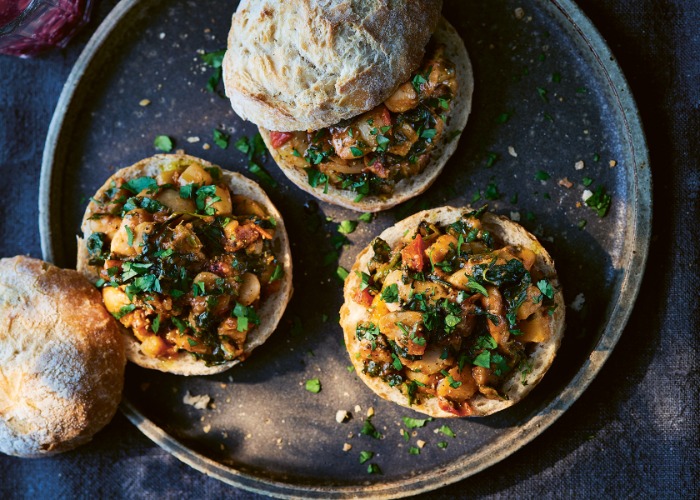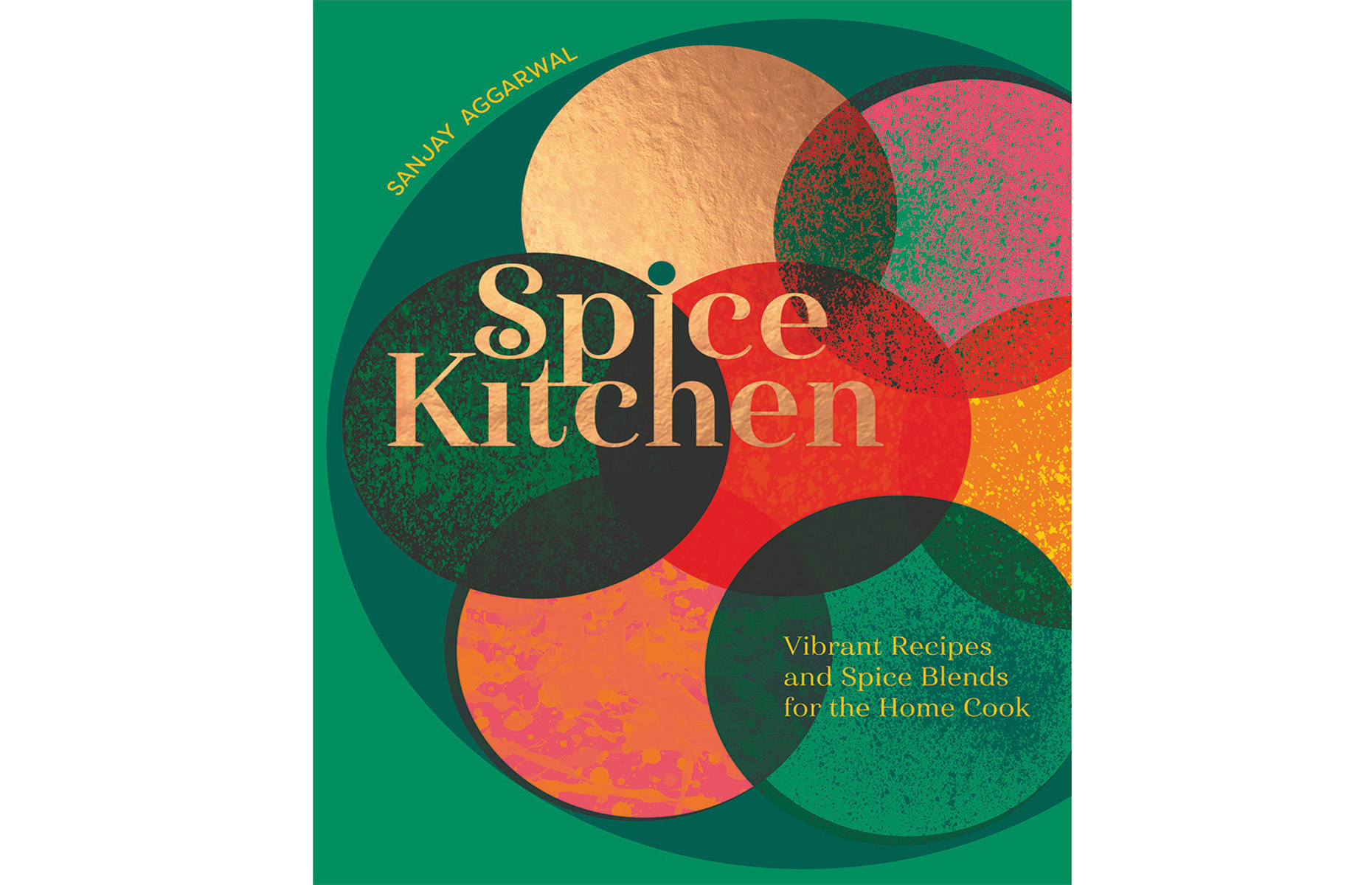Vegetarian bunny chow recipe

If you’ve ever travelled to South Africa, chances are you encountered bunny chow, perhaps the country’s most famous street food. The Durban speciality sees a rich, beautifully spiced curry stuffed into a hollowed-out bread roll.
As with many of the world’s most interesting, and delicious, dishes, bunny chow has a rich cultural backstory, with various theories as to its origins. The most widely held is that the dish was invented by migrant Indian workers in the 1940s. Looking for a way to easily transport their lunch to the plantations, they stored their curries – usually bean or vegetable – inside bread rolls until it was time to eat.
The idea took off beyond the sugarcane fields, and the result is a comforting and easy-to-eat dish, where the fragrant curry sauce soaks beautifully into the remaining bread.
The recipe features in Spice Kitchen: Vibrant Recipes and Spice Blends for the Home Cook, by Sanjay Aggarwal, who opts for a traditional vegetable curry filling. In it, Sanjay walks us through his family’s love of cooking – sharing his mother’s vast knowledge of spices and her heritage growing up in Kenya and India.
Her deep knowledge of food, and little everyday tricks, are woven through its pages. “I have never known Mum to be without an ice cube tray full of ginger-garlic paste in her freezer and a Tupperware container of the stuff in her fridge,” shares Sanjay. “It’s so easy to make and will store well, so definitely worth spending a bit of time over the weekend getting a big batch made up in advance.”
Things to note:
You can use the insides of the bread rolls to make breadcrumbs. Spread over a baking tray and bake in the oven at 170°C/150°C fan/325°F/gas mark 3 for 20 minutes, or until completely dried. When cool, place in a plastic bag and crush until you have breadcrumbs. Store in an airtight container or freeze.
If you can’t get Sri Lankan curry powder, substitute with the same quantity of Indian or Madras curry powder.
You can find dried tamarind, used for the optional tamarind chutney, in most Indian supermarkets.
For a slightly less sweet tamarind chutney, use pitted dates instead of sugar.
For US ingredients and measurements, use the drop-down menu and select ‘Cups’.
Ingredients
- 125 g fresh ginger, peeled and roughly chopped
- 125 g garlic, peeled and roughly chopped
- 0.5 tsp salt
- 1 tbsp vegetable, sunflower or rapeseed oil
- 4.4 oz fresh ginger, peeled and roughly chopped
- 4.4 oz garlic, peeled and roughly chopped
- 0.5 tsp salt
- 1 tbsp vegetable, sunflower or rapeseed oil
- 4.4 oz fresh ginger, peeled and roughly chopped
- 4.4 oz garlic, peeled and roughly chopped
- 0.5 tsp salt
- 1 tbsp vegetable, sunflower or canola oil
- 4 crusty white bread rolls
- 3.5 tbsp vegetable, sunflower or rapeseed oil
- 1 large onion, finely diced
- 2 medium potatoes, peeled, washed and diced
- 1 green chilli, seeds and membrane removed, minced
- 2 tbsp ginger-garlic paste
- 1 tsp garam masala
- 1 tsp Sri Lankan curry powder
- 2 large tomatoes, diced
- 0.5 tsp sugar (optional)
- 1 x 400g tin butter beans, drained and rinsed
- 100 ml passata
- 100 ml water
- 1 handful spinach, fresh or frozen (optional)
- 2 tbsp coriander, roughly chopped plus a little extra to garnish
- 1 salt and freshly ground black pepper, to taste
- 2 tamarind chutney, to serve (optional, see recipe below)
- 4 crusty white bread rolls
- 3.5 tbsp vegetable, sunflower or rapeseed oil
- 1 large onion, finely diced
- 2 medium potatoes, peeled, washed and diced
- 1 green chilli, seeds and membrane removed, minced
- 2 tbsp ginger-garlic paste
- 1 tsp garam masala
- 1 tsp Sri Lankan curry powder
- 2 large tomatoes, diced
- 0.5 tsp sugar (optional)
- 1 x 400g tin butter beans, drained and rinsed
- 3.5 fl oz passata
- 3.5 fl oz water
- 1 handful spinach, fresh or frozen (optional)
- 2 tbsp coriander, roughly chopped plus a little extra to garnish
- 1 salt and freshly ground black pepper, to taste
- 2 tamarind chutney, to serve (optional, see recipe below)
- 4 crusty white bread rolls
- 3.5 tbsp vegetable, sunflower or canola oil
- 1 large onion, finely diced
- 2 medium potatoes, peeled, washed and diced
- 1 green chili, seeds and membrane removed, minced
- 2 tbsp ginger-garlic paste
- 1 tsp garam masala
- 1 tsp Sri Lankan curry powder
- 2 large tomatoes, diced
- 0.5 tsp sugar (optional)
- 1 x 14oz can lima beans, drained and rinsed
- 0.4 cup passata
- 0.4 cup water
- 1 handful spinach, fresh or frozen (optional)
- 2 tbsp cilantro, roughly chopped, plus a little extra to garnish
- 1 salt and freshly ground black pepper, to taste
- 2 tamarind chutney, to serve (optional, see recipe below)
- 250 ml water
- 300 g sugar, or equal amount of pitted dates
- 0.5 tsp salt, to taste
- 0.5 tsp harissa, to taste
- 1 x 200g pack dried tamarind
- 8.8 fl oz water
- 10.6 oz sugar, or equal amount of pitted dates
- 0.5 tsp salt, to taste
- 0.5 tsp harissa, to taste
- 1 x 200g pack dried tamarind
- 1.1 cups water
- 10.6 oz sugar, or equal amount of pitted dates
- 0.5 tsp salt, to taste
- 0.5 tsp harissa, to taste
- 1 1x 7oz pack dried tamarind
Details
- Cuisine: South African
- Recipe Type: Vegetarian
- Difficulty: Easy
- Preparation Time: 40 mins
- Cooking Time: 60 mins
- Serves: 4
Step-by-step
For the ginger-garlic paste:
- Add the chopped ginger, garlic, salt and oil to a blender or food processor. Blend until smooth.
- Scoop the paste into a clean jar and store it in the fridge for 3-7 days. The garlic may turn slightly green – this happens when crushed garlic reacts with the air and oxidises – but don’t worry, it’s still fine to use. Alternatively, freeze the paste using an ice cube tray. Once frozen, pop the cubes into a freezer bag. The frozen paste will last a few months.
For the bunny chow:
- Preheat the oven to 180°C fan/200°C/400°F/gas mark 6.
- Grab the bread rolls and slice off the tops (reserving them for later). Carefully scoop out the soft interior from the rolls to make a cavity without going right to the base: you want the buns intact with no holes for the curry to fall through.
- Place the tops back on the hollowed-out buns and arrange them on a baking sheet. Set aside.
- Heat the oil in a heavy-bottomed frying pan (skillet) over a medium heat. Once hot, add the onion, potatoes and chilli.
- Cook gently for about 8 minutes, until the vegetables have softened and taken on some colour. As the starch comes out of the potatoes, they may stick to the bottom of the pan. This is fine and will add flavour, but make you stir the mixture constantly, so it doesn’t burn.
- Next, add the ginger-garlic paste and cook for a further minute.
- In the meantime, bake the sliced bread rolls and tops for 6-8 minutes to lightly brown and cook through.
- Stir the garam masala, Sri Lankan curry powder, diced tomatoes, sugar (if using), and salt and pepper into the pan with the onions and potatoes. Cook for a further 3 minutes, stirring regularly.
- Next, add the butter (lima) beans, passata and water. Simmer for 5-8 minutes or until the potatoes are soft. Add the spinach (if using).
- Turn off the heat and add the fresh coriander (cilantro). Stir to combine.
- Take your bread rolls out of the oven and carefully fill them with the mixture.
- Drizzle over the tamarind chutney (if using) and sprinkle with the remaining coriander (cilantro).
- Pop the bread lids back on and serve at once.
For the tamarind chutney:
- Place a large, heavy-bottomed saucepan over a medium heat. Add the water, sugar (or dates), salt and harissa. Break the tamarind into small pieces and add to the pan.
- Bring to a boil and simmer for 8-10 minutes until the tamarind dissolves.
- Turn off the heat and strain using a sieve (strainer) into a bowl. You’ll be left with a pulp in your sieve (strainer) packed with flavour. You’ll want to get more flavour out of it, so don’t throw it away. With the bowl underneath, add a little water to the pulp (about 1 tbsp at a time) and keep mixing, adding more water, and pushing the pulp through the sieve until you can no longer extract anything.
- Discard the remaining pulp and decant the chutney into a jar. This recipe makes around 300 ml (1¼ cups) of sauce, enough to use with plenty left to refrigerate for later.
Recipe adapted from Spice Kitchen: Vibrant Recipes and Spice Blends for the Home Cook by Sanjay Aggarwal. (Quadrille, £22) Photography by Dan Jones.

Spice Kitchen: Vibrant Recipes and Spice Blends for the Home Cook by Sanjay Aggarwal
Win a copy of Spice Kitchen
To enter, fill in the form below with your details before 23.59 BST on 16 July 2023.
Most Recent
Comments
-
REPORT This comment has been reported.
Do you want to comment on this article? You need to be signed in for this feature









11 July 2023